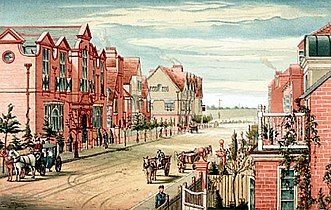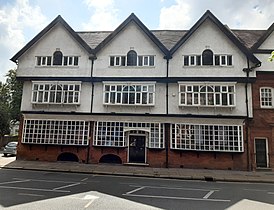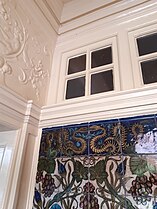The Tabard, Chiswick

The block of three buildings containing The Tabard
The first floor of the pub building is host to the Tabard Theatre.
The block was most likely inspired by Holborn's 1585
Building
Purpose
The block, including no. 2 Bath Road, was built in 1880 by the architect
-
The Tabard inn and the Bedford Park Stores were among the community buildings meant to form the focal point of Jonathan Carr's Bedford Park garden suburb.[3]
Inspiration for design
A group from the Architectural Association paid a visit in January 1880 and commented that "the buildings will comprise a row or terrace of seven gables, like the old row in Holborn, and will include, beside the stores, a private house for the manager, [and] an old-fashioned inn".
-
Norman Shaw's plan for Bedford Park Stores and Hostelry, 1880
-
The "heavily projecting bays"[3] of the 15th century Sparrowe's House, Ipswich
-
The "seven gables"[4] of Staple Inn, Holborn, 1585, as it looked in the 1880s
-
The Bedford Park Stores, the manager's house, and The Tabard
Exterior
The 3-storey block containing the stores, manager's house, and pub is built in red brick and
Pub
The Tabard pub has an entrance porch with Tuscan columns; to either side are windows divided into many small panes. The roughcast first floor of the pub has a pair of projecting bow windows, with small round windows on either side; a third similar gable faces west. A cornice forms an overhang above the windows, topped by two tile-hung gables, each with five small mullioned windows.[1] The architectural historian Nikolaus Pevsner described the Tabard as "especially attractive, with tile-hung gables and very original shallow-curved, completely glazed bay-windows".[7] The swing sign was painted in 1880 by Thomas Matthews Rooke, one of the artists resident in Bedford Park.[3][8] The original sign was lost, but it was rediscovered during the 2016 refurbishment.[9]
The pub, depicted by Thomas Erat Harrison, was among the buildings celebrated in an 1882 illustrated book Bedford Park on the then-fashionable garden suburb.[10]
-
1881 photograph by Bedford Lemere, looking east along Bath Road. The Vicarage is still under construction, without a roof; there are as yet no corner shops in front of the Tabard.
-
Swing sign by TM Rooke, curved bay-windows
-
School of Art, Stores and Tabard Inn by Thomas Erat Harrison, 1882
-
Tabard Inn and St Michael and All Angels Church by Thomas Matthews Rooke, c. 1895. The view (now blocked) is from the south.
-
Front window and column
House
The central house is of red brick on ground and first floors, contrasting with the pub. The four windows on the first floor are separated by Doric pilasters of red brick. Its gables are roughcast.[1]
Stores
The stores has three wide projecting shop-windows of many panes occupying most of its front face, above a red brick wall containing two lunettes for the basement; the front door is set in the middle window. The roughcast first floor has wide projecting 'Ipswich' pattern oriel windows, supported on wooden brackets. The second floor, also roughcast, projects strongly; each bay has a seven-light window, the centre light larger than the rest and arched.[1]
-
Bedford Park Stores, front on to Bath Road
-
'1880' drainbox
-
Rear, corner view from Flanders Road
Pub interior
On the ground floor of The Tabard are the original
The first floor (now the theatre) is accessed by a staircase in the courtyard, again panelled up to the dado rail.[1]
-
Tiled entrance
-
Entrance tiles - ornamental plasterwork
-
Entrance ornamental plasterwork
The poet and campaigner for
Usage
The pub is now managed by
On the first floor is the Tabard Theatre, an intimate fringe theatre which as well as putting on productions of plays has hosted comedians such as Al Murray, Harry Hill and Russell Brand.[8]
The Bedford Park Stores building is now used as offices.[1]
References
- ^ a b c d e f g h i Historic England. "Tabard Hotel public house (1079594)". National Heritage List for England. Retrieved 1 September 2017.
- ^ "1879 - The Tabard Inn & Stores, Bedford Park, London". Archiseek. 25 August 2010. Retrieved 5 August 2021.
- ^ ISBN 978-1-317-27960-0.
- ^ a b "Bedford Park". The Builder: 139, column 3. 31 January 1880.
- ^ Historic England. "The Ancient House (1037756)". National Heritage List for England. Retrieved 8 August 2021.
- ^ Stamp, Gavin (23 July 2015). "The lamentable loss of Britain's pubs". Apollo Magazine. Retrieved 12 August 2021.
- OCLC 24722942.
- ^ a b c d "Tabard in Chiswick". Greene King Pubs. Archived from the original on 1 September 2017. Retrieved 22 July 2021.
- ^ "Tabard". WhatPub. Retrieved 28 April 2024.
- OCLC 193146366.
- ^ Bowes, Kate (2 October 2019). "Betjeman and the Battle of Bedford Park". The Chiswick Calendar. Retrieved 10 August 2021.

![The Tabard inn and the Bedford Park Stores were among the community buildings meant to form the focal point of Jonathan Carr's Bedford Park garden suburb.[3]](http://upload.wikimedia.org/wikipedia/commons/thumb/3/3a/Focus_of_Bedford_Park_Garden_Suburb.png/588px-Focus_of_Bedford_Park_Garden_Suburb.png)

![The "heavily projecting bays"[3] of the 15th century Sparrowe's House, Ipswich](http://upload.wikimedia.org/wikipedia/commons/thumb/1/17/Ipswich_Ancient_House.jpg/278px-Ipswich_Ancient_House.jpg)
![The "seven gables"[4] of Staple Inn, Holborn, 1585, as it looked in the 1880s](http://upload.wikimedia.org/wikipedia/commons/thumb/5/54/Staple_Inn._ILN_1886.jpg/278px-Staple_Inn._ILN_1886.jpg)












